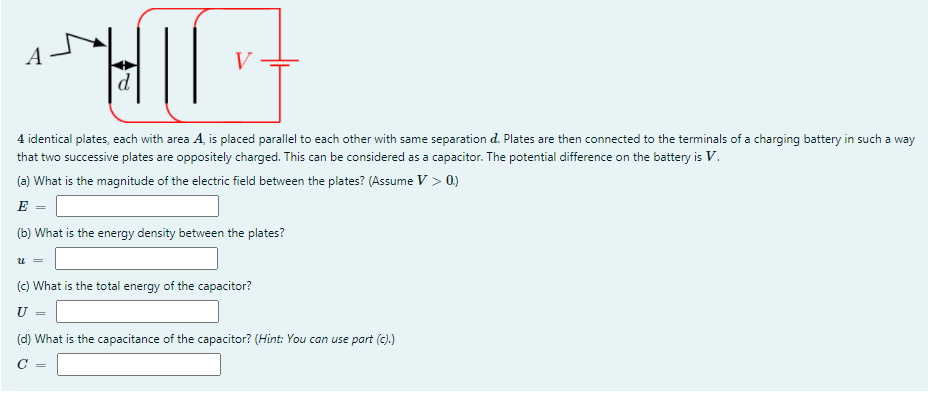A d 4 identical plates, each with area A, is placed parallel to each other with same separation d. Plates are then connected to the terminals of a charging battery in such a way that two successive plates are oppositely charged. This can be considered as a capacitor. The potential difference on the battery is V. (a) What is the magnitude of the electric field between the plates? (Assume V > 0.) E (b) What is the energy density between the plates? u = (c) What is the total energy of the capacitor? U = (d) What is the capacitance of the capacitor? (Hint: You can use part (c).) C =
A d 4 identical plates, each with area A, is placed parallel to each other with same separation d. Plates are then connected to the terminals of a charging battery in such a way that two successive plates are oppositely charged. This can be considered as a capacitor. The potential difference on the battery is V. (a) What is the magnitude of the electric field between the plates? (Assume V > 0.) E (b) What is the energy density between the plates? u = (c) What is the total energy of the capacitor? U = (d) What is the capacitance of the capacitor? (Hint: You can use part (c).) C =
Related questions
Question

Transcribed Image Text:V
d
4 identical plates, each with area A, is placed parallel to each other with same separation d. Plates are then connected to the terminals of a charging battery in such a way
that two successive plates are oppositely charged. This can be considered as a capacitor. The potential difference on the battery is V.
(a) What is the magnitude of the electric field between the plates? (Assume V > 0)
E
(b) What is the energy density between the plates?
u =
(c) What is the total energy of the capacitor?
U =
(d) What is the capacitance of the capacitor? (Hint: You can use part (c).)
C =
Expert Solution
This question has been solved!
Explore an expertly crafted, step-by-step solution for a thorough understanding of key concepts.
Step by step
Solved in 4 steps with 1 images
